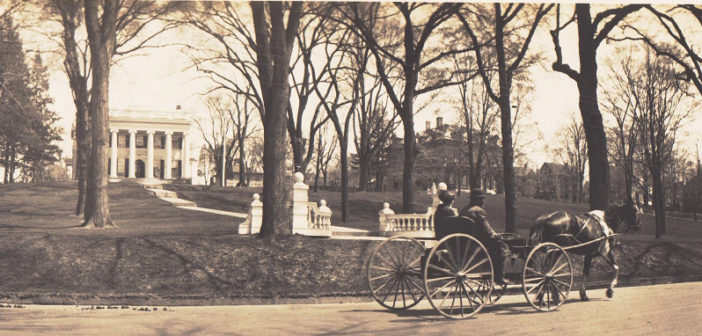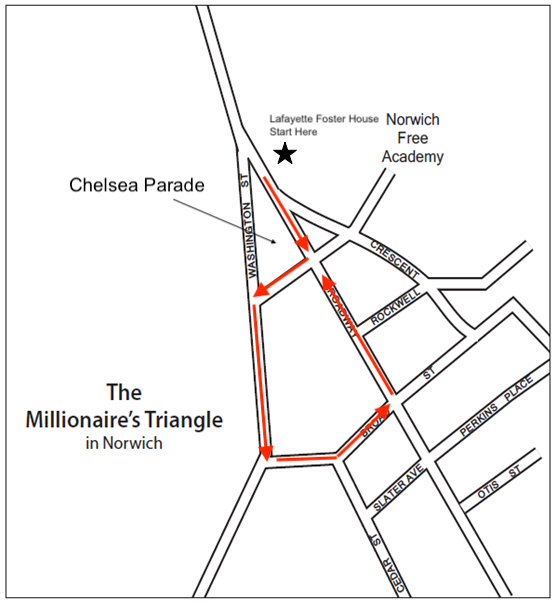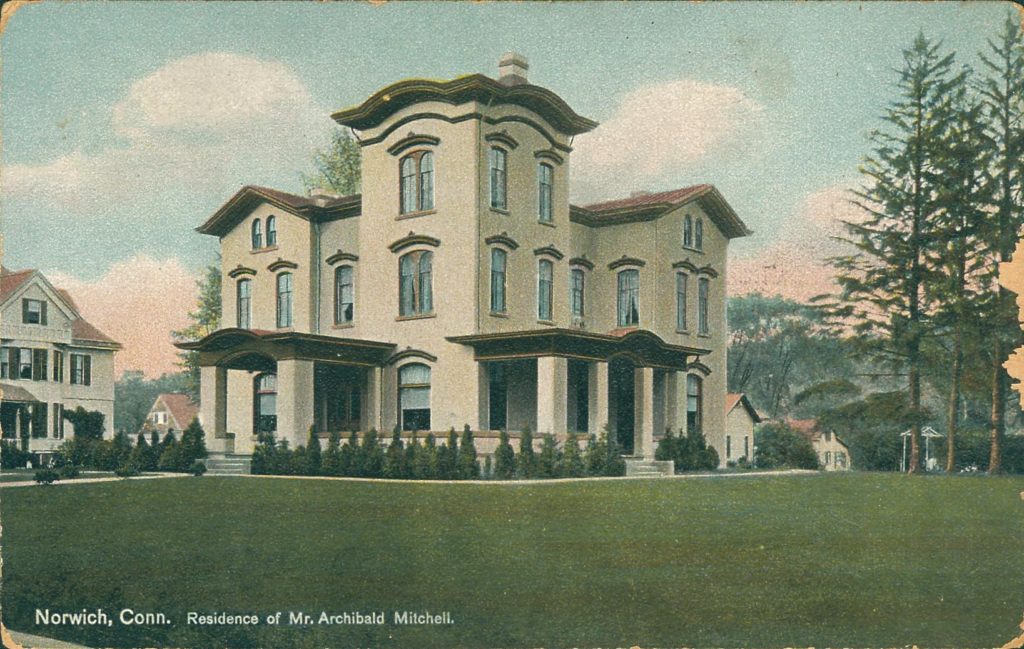By Tricia Staley
(c) Connecticut Explored Inc., Summer 2021
Subscribe/Buy the Issue!
A vice president of the United States, governor of Connecticut, congressmen, generals, major manufacturers and merchants, the head of a major pharmaceutical company, owners and executives of railroads and shipping lines: During the second half of the 19th century, these distinguished people lived in Norwich, Connecticut. Many lived in the mansions that line the city’s “Millionaires’ Triangle,” an area where the major thoroughfares of Washington Street and Broadway converge at Chelsea Parade, a triangular expanse of grass that was a military parade ground during the War of 1812. Just off the Parade is the seven-acre campus of Norwich Free Academy, the independent preparatory school founded in 1854 by the city’s most illustrious residents.
Located halfway between Boston and New York City at the confluence of three rivers, which made it an excellent location for water-powered mills, Norwich by the eve of the Civil War had become a transportation and commerce center—and the third-largest city in Connecticut. After visiting the city in 1851, the noted essayist and clergyman Henry Ward Beecher christened Norwich “The Rose of New England” in a column he wrote for the New York Independent extolling the beauties of the city.
Through the 1840s and 1850s, wealthy mill owners, prominent merchants, and other professional men moved to Norwich and established residences that combined the pleasures of natural settings with close proximity to their mills, wharves, stores, and businesses. Their homes reflected their incomes: the 1865 tax list shows 22 Norwich residents with incomes exceeding $10,000 a year, which would today have the buying power of about $2 million, according to measuringworth.com. In contrast, the skilled hands in the local mills earned $200 to $300 a year.
The mansions of prominent families such as the Slaters, Fosters, Nortons, Converses, Williamses, and others were situated on estates of 5 to 10 acres, often surrounded by ornamental fences. Properties on the west side of Washington Street extended to the Yantic River. They featured greenhouses and graperies; nearly all had a carriage house. Census records and city directories indicate most families had several maids, a cook, and often a coachman. By the 1880s, census records indicate gardeners were resident at most of the estates.
A glimpse into their lives is provided by Edith Carow Roosevelt, second wife of Theodore Roosevelt, who was born in the home of her maternal grandfather General Daniel P. Tyler at 130 Washington Street. When raising troops at the start of the Civil War, Governor Buckingham chose Tyler, a West Point graduate, to command the state’s troops. General Tyler and his men led the advance at the first Battle of Bull Run in July 1861. During the 1920s Edith Roosevelt wrote American Backlogs, a family history that included letters exchanged while her mother Gertrude Tyler was at a finishing school in Paris in the early 1850s. On August 23, 1852 Gertrude’s mother Emily Tyler wrote to her daughter, “There was quite an alarm the other day about William Greene [who lived across the street], it seems he and Frank Goddard were shooting together and a ball from Frank’s pistol grazed William’s side. There was a terrible bustle about it, they had two Doctors, and the whole neighborhood was alarmed, not much harm was done, but Will stalks around quite a Hero.”
The city’s newspapers published accounts of parties, weddings, and other events. On election night 1860 the Morning Bulletin described the “illuminations” displayed along Broadway and Washington Street as Republican homeowners celebrated the election of Abraham Lincoln, who had stayed in Norwich the previous year.
The Norwich Courier devoted two entire columns to the November 1868 marriage of Mary Day Reynolds to William A. Buckingham II, the Connecticut governor’s nephew. The writer enthused about the dresses and jewelry worn by the bride and her attendants, both mothers, and many of the women in attendance and about the decorations at the church and reception site: Ridge Hill, the bride’s family estate. Nearly a quarter of a column was devoted to a breathless description of “The Presents,” including “numerous and valuable jewels.” The article listed many prominent attendees, including then-Senator-Elect William Buckingham, Mrs. Lafayette Foster (wife of the former senator), Mayor and Mrs. Lorenzo Blackstone, Ashburton Webster (grandson of Daniel Webster) and other Webster family members, Dr. Charles Osgood, and John F. Slater.
A Walk Around the Millionaires’ Triangle
At the apex of Chelsea Parade, at 315 Broadway, is the Italianate home of U.S. Senator Lafayette S. Foster, built c. 1855 and today part of Norwich Free Academy. Foster, who served in the United States Senate from 1855 to 1867, was a lawyer with a keen interest in politics. The Memorial Sketch published after his death described Foster as “a rare companion” whose “flow of genial and witty conversation made him a favorite in the most cultivated circles.”
Two weeks after Foster was elected senate president pro tempore, John Wilkes Booth and his co-conspirators launched their plot to assassinate President Abraham Lincoln and Vice President Andrew Johnson, among others. When they killed only Lincoln, Johnson became president and Foster became the de facto vice president (the position didn’t formally exist then, but newspapers across the country identified Foster as vice president or acting vice president.)
At the foot of the green at 9 Chelsea Parade is the square three-story Joseph Teel House built in 1789 as a tavern and inn. It became the home of General William Williams and Harriet Peck Williams after their marriage in 1812. Williams made his fortune as a manufacturer and merchant and retained a lucrative interest in a New London whaling partnership until his death. The couple was known for their philanthropy, particularly in support of education. In addition to a financial contribution, General Williams donated seven acres of land for the NFA campus. Harriet, wealthy in her own right, contributed funds for a library to be named for her father, Captain Bela Peck. In 1870 she donated land on Broadway for construction of Park Congregational Church. In her will she left a million dollars to establish a school for girls in New London, today known as the Williams School.
The walking tour turns south onto Washington Street. Around 1840 Henry Norton built the Greek Revival mansion at 188 Washington Street. Norton, a Branford native, and two brothers built a lucrative wholesale grocery business, then expanded their interests to include steamships, railroads, and manufacturing.
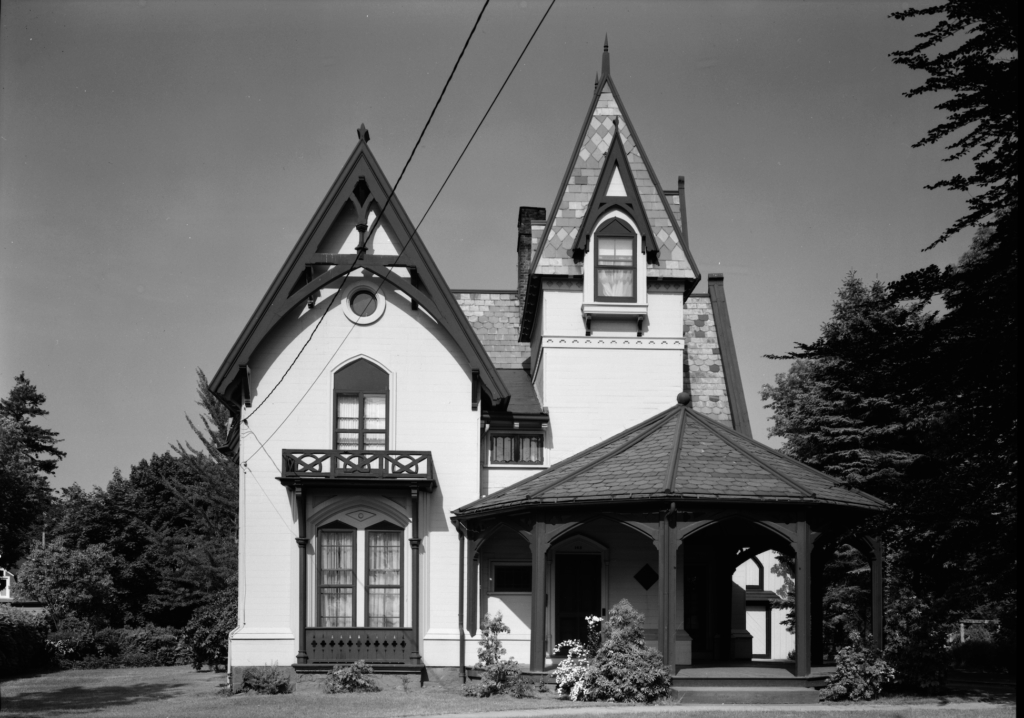
left and below: Col. Charles A. Converse House, 185 Washington Street, Norwich, c. 1930s. Historic American Buildings Survey, Library of Congress
In 1868 merchant-turned-gunmaker Charles Converse founded the Hopkins & Allen Arms Company, which became the third-largest gun-maker in the United States (behind Colt in Hartford and Winchester in New Haven). Charles and his wife Caroline built a fine example of the Gothic Revival style at 185 Washington Street after the Civil War. Converse funded an addition to the Slater Memorial Museum in 1906.
The eclectic pair of houses at 171 and 183 Washington Street were built by Leonard Ballou around 1845. One became the home of his daughter Amelia and her husband A. H. Almy. Ballou lived in the other. Trained as a millwright and engineer, Ballou, a Rhode Island native, became a pioneer of water-powered mills in eastern Connecticut. He grew a small cotton mill into a major manufacturing operation that ran as many as 26,000 spindles in the Attawaugan section of Killingly. Ballou had a reputation for honesty and fair dealing. A History of New London County, with Biographical Sketches of Many of Its Pioneers and Prominent Men described Ballou as “a peacemaker in all difficulties … often looked to by friends to arrange mutual misunderstandings.”
Ballou’s other daughter Lydia married John Young, the son of another Killingly mill owner. Young and his friend Charles Lewis Tiffany opened a shop in New York City. Ten years later, Tiffany and Company was the largest diamond merchant in the country. Tiffany married Young’s sister Harriet, and a third partner married Young’s sister Maria. Later, Charles and Harriet Tiffany’s son Louis Comfort Tiffany married Mary Woodbridge Goddard, whose family lived near the Ballous. Louis Comfort Tiffany designed the stained-glass windows at United Congregational Church at 87 Broadway and at Christ Episcopal Church at 78 Washington Street.
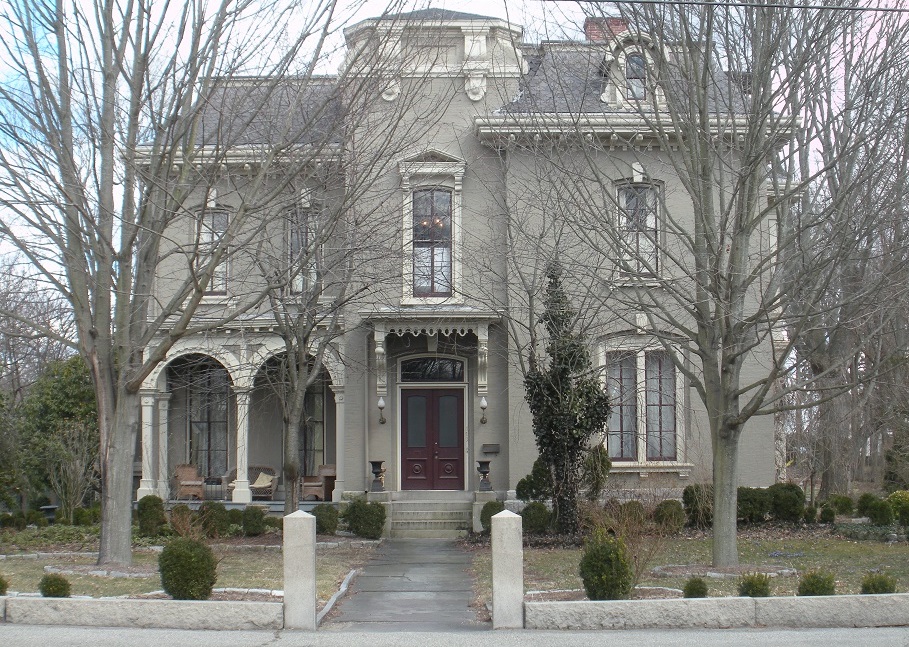
Leonard Ballou, his daughter Lydia, and
her husband John Young lived at 173 Washington Street, Norwich. photo: Tricia Staley
A few hundred feet south of Leonard Ballou’s house is the Greek Revival home of General William Appleton Aiken at 157 Washington Street. Just after the Civil War began in April 1861, Governor William A. Buckingham (who lived on Main Street) chose the 29-year-old Aiken as his aide to deliver dispatches to President Lincoln. Aiken married Buckingham’s daughter Eliza in August, and the house, built in 1799 (with 1867 Greek Revival additions), was a wedding gift from her father. Appointed quartermaster general of Connecticut, Aiken proved instrumental in obtaining supplies and equipment for Connecticut’s soldiers. After the war he became president of Norwich Nickel and Brass Company.
Dr. Charles Osgood lived next door in another Greek Revival house built in the 1850s at the corner of Washington and Broad streets. Old photographs show a handsome house set back from the street, its front yard filled with plantings and a lovely classical fountain (now on the NFA campus). Dr. Osgood was the proprietor of a drug company whose most successful remedy, “Osgood’s India Cholagogue,” gained a widespread reputation as a cure for malaria. Charles Fenner’s Twentieth Century Formulary (1904) called it “one of the most popular and effective ague cures ever put on the market.”
Across the street at 154 Washington, is Pinehurst, the Italianate villa designed by architect Gervase Wheeler and built in 1860 for Joshua Newton Perkins, one of the early Wall Street financiers. It was initially a summer home with a wrap-around porch commanding a view of the Yantic River but later became his full-time residence. Perkins lost his first fortune, made another, then lost that in the 1869 Black Friday gold panic triggered by Jay Gould and Jim Fiske. Awards named for Perkins are given to high-achieving graduating students at NFA.
The Millionaires’ Triangle turns west up Broad Street, but a number of millionaires and their families lived farther south. They included the Greenes (top image), whose holdings stretched for several hundred feet along Washington Street. Nineteenth-century accounts, including the memorial published by the family after his death, describe William P. Greene as the son of the wealthiest man in Boston. He came to Norwich in the early 1830s to oversee his father’s interests in the Falls Company, one of the city’s earliest textile mills, on the Yantic River. Later, the factory moved to what became the village of Greeneville, along the Shetucket River on the city’s east side. His sons Gardiner Greene and James Lloyd Greene lived in homes on the property. Gardiner’s house was razed for construction of Buckingham School (which has itself been razed); Greene Avenue runs through the site of William Greene’s house. Only the brick house of James Greene, who served as the city’s mayor during the Civil War, remains. It is now divided into condominiums with the address 26 Greene Avenue. (A third son, William P. Greene Jr., moved to 170 Washington Street when he married Theodosia Thompkins, whose parents lived in the mansard-roof house next door.)
Across the street lived General Daniel Tyler, and next door to him lived the Blackstones, the second-wealthiest family in Norwich according to the 1865 tax list. Lorenzo Blackstone built a fortune as a rubber merchant in England. Blackstone’s wife Emily was the sister of the Norton brothers, and the couple’s home at 138 Washington Street was a short walk to her brothers’ homes. Their son William Blackstone and his wife Julia built an elaborate villa c. 1888 at 206 Washington Street (which has since been demolished).
On Broadway
Returning to the triangle, the estate at the corner of Broad and Broadway belonged to the wealthiest of all: John F. Slater, who came from Rhode Island to supervise his family’s Connecticut mill holdings. When he moved to Norwich about 1842, he bought the elegant house at the corner of Main and Park streets (now the former Elks Home). Two years later, he married the girl next door, Marianna Hubbard, whose home stood on the site of today’s post office. The Slaters bought the Broadway estate in 1861.
Slater was president of the group that restructured the Orrey Taft mill in Norwich’s Taftville section, which became the fabulously successful Ponemah Mill. [See “A Strike Transforms a Village,” Winter 2019-2020.] Slater catapulted to national prominence as a major philanthropist when he established the million-dollar John F. Slater Fund for the Education of Southern Freedmen in 1882, predating Carnegie, Rockefeller, and Vanderbilt by a decade.
In 1885 Slater’s son William married John Young’s niece Ellen Burnett Peck at her mother’s home on Lincoln Avenue. John Slater had died the previous year. William began planning the memorial to his father that became the Slater Memorial Museum. Architect Stephen Earle of Worcester, Massachusetts was engaged to design the building on the NFA campus.
Will and Ellen Slater left Norwich in 1896 for France, then Washington, D.C. The estate at 228 Broadway was sold to developers, who dismantled the mansion and divided the land into building lots. All that remains is one wing of the house at 18 Elmwood Avenue and the coachman’s cottage at 2 Slater Avenue.
The c. 1865 Italianate mansion on the other corner of Broadway and Broad belonged to Marianna Slater’s brother James Hubbard and his wife Charlotte and, later, his son Charles and his wife Catherine. James’s father Amos Hubbard co-published the Norwich Courier and established a paper mill on the Yantic River. The Hubbards continued to run the family’s textile and paper mills in Greeneville. This home has since been divided into apartments.
Across Broadway from the Slaters was Colonel George Perkins, treasurer of the Norwich and Worcester Railroad for more than 50 years. Perkins, a paymaster during the War of 1812, was present at the Battle of Stonington, according to the 1894 booklet Norwich: The Rose of New England (The Norwich Evening Record). The article noted he had entertained seven presidents at his home. On August 5, 1888 he shook hands with each of the 1,500 guests at his 100th birthday celebration, as numerous newspapers, including the Boston Herald (August 7, 1888), recounted. By 1871, part of his estate became the site of St. Patrick’s Church, built to serve the city’s burgeoning Irish population, many members of which were servants at the surrounding mansions.
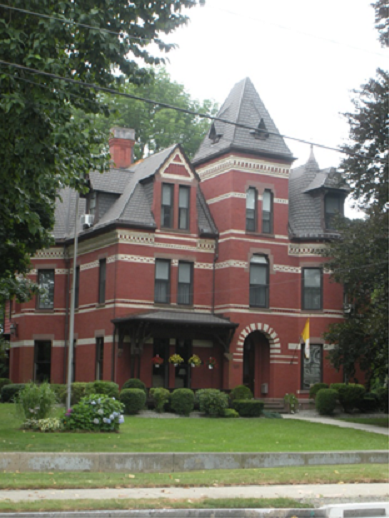
Marianna Hubbard Slater House, designed by Stephen Earle, 274 Broadway, Norwich, now the residence of the Roman Catholic Bishop of Norwich. photo: Tricia Staley
The walking tour turns north on Broadway. The house at 274 Broadway was built by 1876 for Marianna Slater, who had separated from her husband John Slater in 1874. She had inherited money upon her father’s death, and John Slater provided $10,000 annually for her living expenses, according to his May 8, 1884 obituary in the New Haven Daily Morning Journal and Courier. The 1880 census shows her living there with a staff that included a cook and a coachman. The house is now the Bishop’s residence of the Roman Catholic Diocese of Norwich.
Nearly three dozen mansions still stand in the area. The Norwich Historical Society published a self-guided tour of the Millionaires’ Triangle as part of its Walk Norwich program, based on my book Norwich and the Gilded Age: The Rose City’s Millionaires’ Triangle (The History Press, 2014). The brochure is available at walknorwich.org/millionaires-triangle-trail/.
Tricia Staley is a retired educator and the author of Norwich and the Gilded Age: The Rose City’s Millionaires’ Triangle(The History Press, 2014), upon which this story is based, and Norwich and the Civil War (The History Press, 2015). She last wrote “A Strike Transforms a Village,” Winter 2019-2020.
Explore!
“The Slaters Go Round the World,” Winter 2011/2012
“John Denison Crocker: Norwich’s Renaissance Man,” Winter 2006/2007
GO TO NEXT STORY
GO BACK TO SUMMER 2021 CONTENTS
Subscribe/Buy the Issue!
Sign up for our bi-weekly e-newsletter
for the latest stories, Grating the Nutmeg podcast,
and programs and exhibitions to see now

